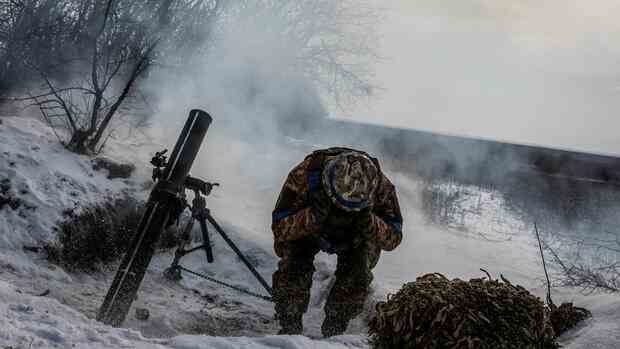Lviv, Brussels, Riga, Berlin On Friday the sirens wailed again in Ukraine, even in far western cities like Lviv there were air raid alarms. “Russia has been attacking Ukrainian cities all night and morning,” Ukrainian presidential adviser Mykhailo Podoliak tweeted – urging the allies to quickly provide Ukraine with fighter jets and long-range missiles as well.
According to the Ukrainian commander-in-chief Valery Zalushny, the Russian army fired 71 cruise missiles, up to 35 S-300 missiles and seven drones at targets in Ukraine within around 14 hours. 61 cruise missiles and five drones were shot down by the air defenses.
Do the air strikes, which again primarily targeted energy infrastructure, mark the start of an expected major Russian offensive? Especially since the Russian forces continued their attacks on the ground along the front line between the towns of Svatove and Kreminna.
Ukrainian President Volodymyr Zelenskiy was clearly concerned during his visit to Brussels on Thursday, according to diplomats from the confidential talks during the EU summit. The prospects for the spring are also classified as worrying in Brussels. Time is running out to strengthen Ukrainian troops for the expected Russian offensive.
Because if Russia’s President Vladimir Putin wants to show a halfway tangible military success by the first anniversary of the beginning of the war on February 24, the offensive operations would have to start “now or soon”, says the former Bundeswehr general and former director of the Federal Academy for Security Policy ( BAKS), Kersten Lahl.
The British MoD, which publishes information from its intelligence services on a daily basis, reported on Friday that Russian troops had made tactical gains in two key regions. Fighters from the Wagner mercenary group in the north of the town of Bachmut advanced two to three kilometers west in the direction of an important connecting road. The Russian troops had also achieved successes in the city of Wuhledar.
However, the advances are said to be associated with sometimes considerable losses of people and material. After an unsuccessful attack, fleeing Russian troops would have left behind at least 30 almost intact vehicles. According to the Ukrainian Defense Ministry, the Russian attackers have already lost 3,258 battle tanks, almost 6,500 armored vehicles and around 2,250 artillery systems since the beginning of the war.
Since Friday night, the Russian army has again launched massive airstrikes on targets in Ukraine.
(Photo: AP)
According to the Washington Institute for the Study of War (ISW), which regularly publishes military analyzes of the situation in Ukraine, the Russian armed forces have recently continued their offensive operations in the area around the city of Luhansk. In addition, Russian troops west of Donetsk and in the area around the city of Avdiivka carried out “limited” attacks with ground forces.
Otto Tabuns, head of the think tank Baltic Security Foundation based in Riga, assumes that from now on the Russian military will step by step increase the pressure on Ukraine and intensify the attacks even further. Compared to the situation at the beginning of the war, the Russian military has learned something new in terms of tactics. “That worries the Ukrainians,” says Tabuns.
In an analysis published a few days ago, security expert Gustav Gressel from the European Council on Foreign Relations (ECFR) wrote that the partial mobilization in September helped Russia to better defend its positions and undertake advances. Around 150,000 to 200,000 soldiers are currently still being trained, but will take part in the fighting in a timely manner.
>> Read here: Cold War infrastructure: Why electricity is still flowing in Ukraine
Despite the sanctions, the Russian defense industry is proving to be surprisingly robust, writes Gressel. Despite predictions that Russia could run out of ammunition, artillery has been firing at a relatively constant level since October. Russian tank production has increased significantly and more modern types such as the T-90M have recently appeared on the battlefield.
Russia will remain on the offensive until early summer
The ECFR expert suspects that Russia will probably remain on the offensive until early summer. Without renewed mobilization, however, it would hardly be able to hold advanced front positions. According to Gressel, a major Ukrainian offensive is unlikely before the second half of the year because the necessary equipment is not yet available.
The Russian attackers now outnumber the Ukrainian defenders, according to several EU countries. The Ukrainian army therefore needs troop carriers, tanks and artillery pieces to compensate for the quantitative disadvantages. And above all, the replenishment of ammunition must not run out. The front is about 1,200 kilometers wide – and correspondingly difficult to hold.
Western supplies of arms and ammunition need to be accelerated, diplomats concede. But supplies in Europe are getting scarce. The manufacturers could not keep up with the orders, which is why the EU countries have long been looking outside of Europe, including in South Korea. But when NATO Secretary General Jens Stoltenberg was recently in Seoul, he was unable to persuade the South Korean government to deliver ammunition.
According to the Riga security expert Tabuns, Russia will now test how long the West can maintain support for Ukraine. And the more escalation potential Russia shows, the more likely Ukraine’s western allies will reconsider new aid, such as the delivery of combat aircraft.
Worries about an escalation of the war fueled reports on Friday that Russia allegedly violated the airspace of the Republic of Moldova and Romania in its recent airstrikes. According to the news portal “Meduza”, Ukrainian commander-in-chief Zalushnyj said that two cruise missiles fired from the Black Sea crossed the borders of both countries on their way to the target.
The Ministry of Defense of Moldova confirmed the information. The Romanian Ministry of Defense denied that its own airspace had been affected.
More: Will Moldova become the second Ukraine? “We urgently need Europe’s support”
